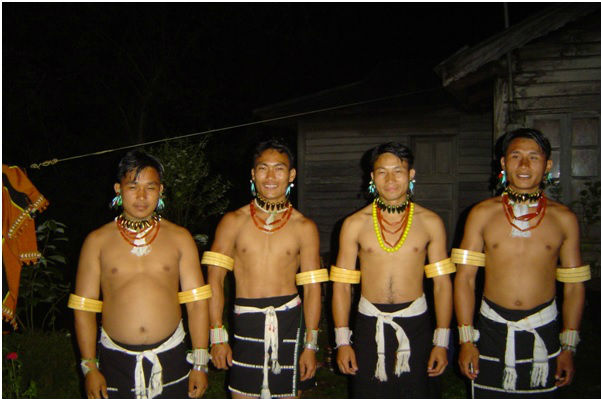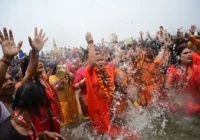Former insurgents have reconciled in one of the longest-running conflicts in the world.
Wars and conflicts grab headlines. The higher the casualty figures, the more prominent the news. Peace and reconciliation are not as interesting by comparison, except for a few occasions when conflicts are prominent or leaders charismatic. We live in an era of the Islamic State and Binyamin Netanyahu. Few know of a place called Nagaland, where the Naga tribes live. Yet it is this part of the world where former enemies have managed to reconcile old blood feuds that have been going on for decades.
Who are the Nagas?
Nagaland is a state on India’s border with Myanmar, where Naga tribes were head-hunters until only a few decades ago. Warriors would literally bring back their enemies’ heads from battle, and the dao was a special weapon wielded by the Nagas for this exact purpose. They have a ferocious reputation as a proud people and live in both Myanmar and India. While the Naga tribes mainly live in Nagaland, they are also scattered across Arunachal Pradesh, Assam and Manipur.
The Nagas are very few in number, with a population of barely 3.5 million. They are divided into numerous tribes with different languages, customs and cultures. Yet they claim to be a people. They were all head-hunters with a violent past. It is important to remember that most of this violence was small-scale, and their lives have a richness that is often ignored in outside representation of the Nagas.
The Nagas were never conquered by anyone, except for a temporary period when they lived under British administration. Even then, their traditional ways of life were largely undisturbed. This was partly because the British saw little economic value in their lands and partly because the Nagas fought valiantly to preserve their autonomy. Several thousand Nagas took part in World War I as part of the Allied Labour Corps. Their homes became the battleground where the Japanese advance was finally halted in World War II. The battle for Kohima was ferocious, and the Nagas played a key role in fighting alongside the British. Villagers from Khonoma played a particularly important role.
After India became independent, the Naga insurgency broke out against New Delhi. The Naga struggle for sovereignty can be traced to January 1929, when Naga leaders submitted their memorandum to the British Simon Commission. They campaigned for de facto independence by asking to remain outside India. This demand wasn’t met. The Nagas declared their independence on August 14, 1947, one day before India became independent. The insurrection continues to this day.
Decades of violence corroded the Naga soul. Over time, tribes, clans and families became divided. Tensions first arose when some Naga leaders proposed a violent struggle while others insisted on non-violence. The former were termed “Underground” and the latter “Overground,” a division that persists till today. Overground leaders were compelled to seek the protection of the Indian government and established the state of Nagaland in the Indian Union on December 1, 1963.
The Naga Underground continued to fight for independence from India. Starting in the early 1980s, the Underground began to splinter as well. Today, there are about seven different groups that spend more time fighting and killing each other instead of struggling for independence. All claim to be fighting for Naga freedom, but they are increasingly more like armed gangs, indulging in mindless violence and perpetuating familial and tribal feuds.
Indian Oppression
Many suspect that Indian intelligence agencies have played a hand in fracturing the Underground. When the Naga insurgency broke out, even the Indian government, led by then-Prime Minister Jawaharlal Nehru, turned oppressive. Many in the government feared a breakup of India. The domino theory held sway. If Nagaland became independent, they reasoned, others would follow and there would be no longer be an India. The remnants, consisting of weak regional states, would be vulnerable to colonization and other forms of exploitation.
New Delhi passed draconian laws to quell the Naga rebellion. In 1953, the Assam Maintenance of Public Order Act came into being. The Assam Disturbed Areas Act followed suit in 1955. Then, in 1958, the Indian parliament passed the Armed Forces Special Powers Act. This was initially supposed to deal with the Naga insurgency but has since been extended to the entire northeast of the country and the state of Jammu and Kashmir. This piece of legislation has achieved much notoriety because it gives a free hand to the armed forces to do what they want. Irom Sharmila of Manipur has gone on an indefinite hunger strike to pressure the Indian parliament to overturn this act.
The Nagaland Security Regulation Act was passed in 1962, the year of the Sino-Indian War. This act is a blot on Indian civilization. Together with the 1958 legislation, it has violated the basic human rights of the Nagas. Indian security forces have had the power to detain arbitrarily, kill with impunity and avoid any judicial scrutiny into their actions. The Nagas have chafed under these laws, and such acts only help the Underground to recruit hot-headed youths for its cause. Many of them become trigger happy and train their guns on each other. This leads to lengthy feuds that destroy the very fabric of Naga society.
Gandhian Principles: Peace and Reconciliation
Today, reconciliation is the most important issue for a deeply divided Naga society. Many initiatives to solve the impasse have failed. Recently, however, an initiative in Khonoma succeeded.
Khonoma is a village where the Naga first resisted British and then Indian rule. The small town resisted the might of the British Empire for about 50 years and was the last Naga village to fall. It provided early leadership to the Naga National Movement that was fighting for independence from India. The first divide between the Overground and Underground took place there. Later, more divisions came into being. Over the years, these divisions led to many killings. Bad blood made life in the village toxic.
In 2004, the people of Khonoma decided to end the bitterness and bloodshed. The past had to be buried once and for all. They decided to create a new future free of fear, hate and violence. The village came together to “heal the soul of Khonoma.”
The people of the village formed the Khonoma Public Commission (KPC). Members of the KPC were selected from all the clans of the village so that everyone was represented. The KPC’s mission statement declared: “We have understood and resolved that yesterday’s wounds and divisions should be healed to enable today’s generation to build a better tomorrow.” The KPC focused on issues that had “divided the village and damaged its capacity to match the challenges of a rapidly changing world.”
The first issue the KPC had to address was the issue of independence. The KPC declared: “Khonoma leaders fully supported the Naga stand for sovereignty.” However, it addressed “moral and spiritual choices regarding the methods and means for achieving goals.” It admitted that serious mistakes were made “resulting in loss of lives and divisions.” The KPC declared that the way forward had to be peaceful. To arrive at a lasting peace, the bereaved family and clan members within the village had to forgive each other. An eye for an eye would no longer fly.
The Reconciliation Process
The reconciliation process was well structured. The Reconciliation Mission Statement said that the Commission would accord “the fullest and equal respect and attention to all issues and instances of wrongs, hurts and misunderstandings, guided by the truth that hurts not transformed are always transferred.”
KPC members made numerous journeys and visits to facilitate sensitive connections and honest interactions between individuals, families and clans. They created an atmosphere of trust and confidence. People made heartfelt apologies for the wounds they inflicted during the most difficult years of the Naga insurrection. Bitterness, doubts, fears, guilt and regrets suffered in silence for years were expressed and heard. Mutual forgiveness and understanding became a liberating experience. The villagers invoked God’s grace and blessing to start afresh.
The KPC invested time in every case and pursued all concerned parties so no doubts or feelings of incompleteness remained. It took ten years for the KPC to complete its work. Reconciliation took place for 22 intra-village killings. The family members of the perpetrators and victims met face to face and forgave each other.
Restitution was a very important part of the reconciliation process. Obviously, lost lives could not be brought back. In such cases, the two sides forgave each other, prayed together and, in many cases, exchanged the Bible. Looted physical items were returned when the actual owners could be identified. When they couldn’t be identified, these possessions were burned or thrown away to symbolize the giving up of the past.
As a result of this reconciliation, a new unity has emerged in the village. Logging has been banned to stop deforestation. Hunting has been banned too, leading to a return of wildlife. Khonoma has become the first green village in India and has put itself on the country’s tourist map.
The key question is whether Khonoma can be a role model for other Naga villages and serve as a catalyst for reconciliation among a people long divided. Only peace among the Nagas could fully heal Khonoma’s soul.
Fair Observer is a nonprofit organization dedicated to informing and educating global citizens about the critical issues of our time. Please donate to keep us going.
The views expressed in this article are the author’s own and do not necessarily reflect Fair Observer’s editorial policy.
Photo Credit: Michal Knitl / Shutterstock.com
Support Fair Observer
We rely on your support for our independence, diversity and quality.
For more than 10 years, Fair Observer has been free, fair and independent. No billionaire owns us, no advertisers control us. We are a reader-supported nonprofit. Unlike many other publications, we keep our content free for readers regardless of where they live or whether they can afford to pay. We have no paywalls and no ads.
In the post-truth era of fake news, echo chambers and filter bubbles, we publish a plurality of perspectives from around the world. Anyone can publish with us, but everyone goes through a rigorous editorial process. So, you get fact-checked, well-reasoned content instead of noise.
We publish 2,500+ voices from 90+ countries. We also conduct education and training programs
on subjects ranging from digital media and journalism to writing and critical thinking. This
doesn’t come cheap. Servers, editors, trainers and web developers cost
money.
Please consider supporting us on a regular basis as a recurring donor or a
sustaining member.
Will you support FO’s journalism?
We rely on your support for our independence, diversity and quality.










Comment